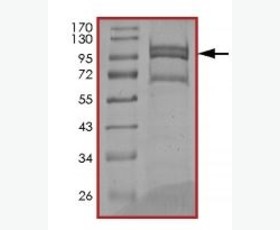Recombinant Human NGAL/Lipocalin-2/LCN2
| Product name: | Recombinant Human NGAL/Lipocalin-2/LCN2 |
| Source: | Human Cells |
| Purity: | Greater than 95% as determined by reducing SDS-PAGE. |
| Buffer Formulation: | Supplied as a 0.2 μm filtered solution of PBS, 50% glycerol,pH7.4. |
| Applications: | Applications:SDS-PAGE; WB; ELISA; IP. |
| Storage: | Avoid repeated freeze/thaw cycles. Store at 2-8 oC for one month. Aliquot and store at -80 oC for 12 months. |
| UOM: | 100ug/50ug/200ug/1mg/1g |
| Source | Human Cells |
| Description | Recombinant Human NGAL is produced by our Mammalian expression system and the target gene encoding Gln21-Gly198 is expressed with a 6His tag at the C-terminus. |
| Names | Neutrophil gelatinase-associated lipocalin, NGAL, 25 kDa alpha-2-microglobulin-related subunit of MMP-9, Lipocalin-2, Oncogene 24p3, Siderocalin LCN2, p25, HNL, NGAL |
| Accession # | P80188 |
| Formulation | Supplied as a 0.2 μm filtered solution of PBS, 50% glycerol,pH7.4. |
| Shipping |
The product is shipped on dry ice/ice packs. |
| Storage |
Store at < -20°C, stable for 6 months after receipt. Please minimize freeze-thaw cycles. |
| Purity |
Greater than 95% as determined by reducing SDS-PAGE. |
| Endotoxin | Less than 0.1 ng/µg (1 IEU/µg) as determined by LAL test. |
| Amino Acid Sequence |
QDSTSDLIPAPPLSKVPLQQNFQDNQFQGKWYVVGLAGNAILREDKDPQKMYATIYELKEDKSYN VTSVLFRKKKCDYWIRTFVPGCQPGEFTLGNIKSYPGLTSYLVRVVSTNYNQHAMVFFKKVSQNR EYFKITLYGRTKELTSELKENFIRFSKSLGLPENHIVFPVPIDQCIDGVDHHHHHH
|
| Background | LCN2 is iron-trafficking protein involved in multiple processes such as apoptosis, innate immunity and renal development. LCN2 binds iron through association with 2,5-dihydroxybenzoic acid (2,5-DHBA), a siderophore that shares structural similarities with bacterial enterobactin, and delivers or removes iron from the cell, depending on the context. LCN2 is involved in apoptosis due to interleukin-3 (IL3) deprivation: iron-loaded form increases intracellular iron concentration without promoting apoptosis, while iron-free form decreases intracellular iron levels, inducing expression of the proapoptotic protein BCL2L11/BIM, resulting in apoptosis. LCN2 is involved in innate immunity, possibly by sequestrating iron, leading to limit bacterial growth. |














